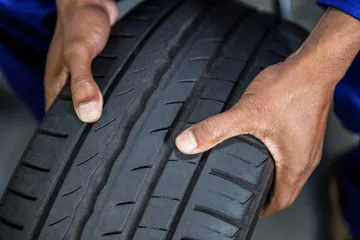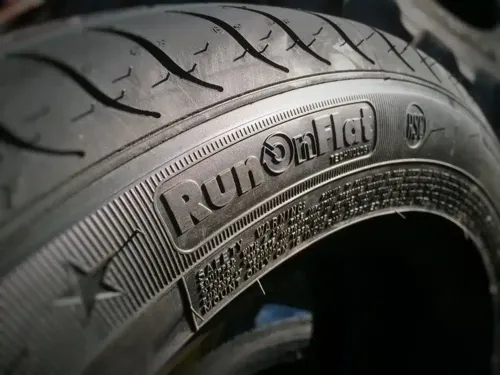What can cause uneven tyre wear?
Discover the common causes of uneven tyre wear
Posted on

Uneven tyre wear is a common problem that affects the performance, safety, and lifespan of your tyres. It can also lead to costly repairs or replacements if not addressed early. Identifying the causes of uneven tyre wear can help you take proactive measures to prevent it and extend the life of your tyres.
In this post, we’ll explore the main reasons why tyres wear unevenly and how to avoid these issues to keep your tyres in top condition.
1. Incorrect Tyre Pressure
One of the most common causes of uneven tyre wear is incorrect tyre pressure. Under-inflated or over-inflated tyres can cause specific areas of the tyre to wear faster than others.
- Under-inflated tyres: When tyres don’t have enough air pressure, the outer edges of the tread will wear down faster. This happens because more of the tyre's surface is in contact with the road, leading to excessive wear on the edges.
- Over-inflated tyres: Tyres with too much air pressure will cause the center of the tyre tread to wear out more quickly, as the tyre bulges and reduces the contact patch.
How to Prevent It:
Check your tyre pressure regularly, ideally once a month, and before long trips. Make sure your tyres are inflated to the manufacturer’s recommended pressure, which can be found in your vehicle’s manual or on the driver’s side door frame.
For further details on tyre pressure, read our blog post How to put air in your tyres?
2. Misalignment of Wheels
Wheel misalignment occurs when your vehicle’s wheels are not aligned properly with each other or the road. This can happen due to hitting potholes, curbs, or from general wear over time. Misaligned wheels cause uneven tyre wear, particularly on one side of the tyre, leading to uneven tread wear.
- Toe misalignment: This type of misalignment causes tyres to point inward or outward, wearing the inner or outer edges more quickly.
- Camber misalignment: If the wheels tilt inward or outward from the vehicle’s body, it can cause one side of the tyre to wear faster than the other.
How to Prevent It:
Have your vehicle’s alignment checked regularly, especially if you notice uneven tyre wear or your car pulls to one side. Alignments should be part of your routine vehicle maintenance to ensure even tyre wear.
3. Improper Tyre Rotation
Tyre rotation involves switching the position of your tyres to ensure they wear evenly. Improper or infrequent tyre rotation can lead to uneven wear, as the front and rear tyres experience different levels of stress. For example, front tyres on front-wheel-drive vehicles tend to wear out faster due to steering and braking forces.
How to Prevent It:
Rotate your tyres every 6,000 to 8,000 miles (or as recommended by your vehicle’s manufacturer) to distribute the wear evenly. Following a proper rotation pattern helps ensure all tyres wear down at the same rate.
4. Worn or Faulty Suspension Components
Your vehicle’s suspension system plays a crucial role in maintaining even contact between the tyres and the road. Worn or faulty suspension components, such as shocks, struts, or ball joints, can cause tyres to lose proper contact with the road, resulting in uneven wear.
When suspension components wear out, they can cause the tyre to bounce or skip on the road, leading to cupping or scalloping, which is an uneven, wavy pattern on the tyre tread.
How to Prevent It:
Have your suspension system inspected regularly and replace worn components as needed. Properly functioning suspension ensures even tyre wear and a smooth ride.
5. Driving Habits
Your driving style can also contribute to uneven tyre wear. Aggressive driving, such as frequent hard braking, rapid acceleration, and sharp cornering, can cause excessive wear on certain parts of the tyres, especially the edges.
How to Prevent It:
Adopt a smoother driving style by avoiding sudden stops and starts. Gradual braking and acceleration help reduce the strain on your tyres and promote even wear.
6. Overloading the Vehicle

Overloading your vehicle beyond its recommended weight limit can put excessive stress on your tyres, causing them to wear unevenly. The extra weight pushes down on the tyres unevenly, particularly on the rear tyres if the load is concentrated in the back, leading to faster wear.
How to Prevent It:
Avoid overloading your vehicle, and check the maximum load capacity in your vehicle’s manual. If you often carry heavy loads, ensure your tyres are rated for higher load capacities to avoid premature wear.
7. Uneven Road Surfaces
Driving frequently on rough or uneven roads, such as gravel, potholes, or poorly maintained streets, can also cause uneven tyre wear. Uneven surfaces create irregular contact between the tyre and the road, leading to excessive wear in certain areas of the tread.
How to Prevent It:
While you can’t always avoid rough roads, try to drive more cautiously on uneven surfaces. Slower speeds and avoiding potholes when possible can help reduce the wear on your tyres.
Final Thoughts
Understanding the causes of uneven tyre wear and how to prevent them is key to maintaining the longevity of your tyres and ensuring a safe, smooth ride. Regular tyre maintenance, including proper inflation, alignment, rotation, and suspension checks, can significantly reduce uneven wear and save you money in the long run.
Remember to inspect your tyres regularly and address any signs of uneven wear as soon as possible to avoid bigger issues down the road.










